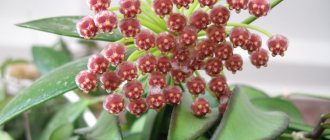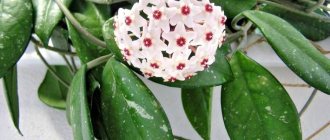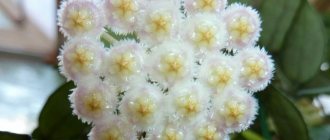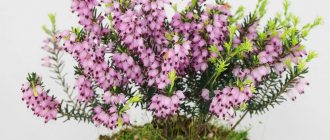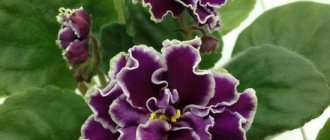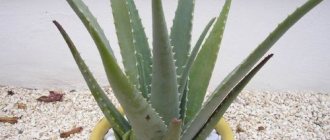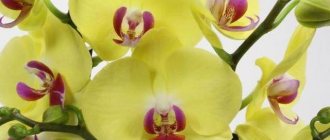Plants » Flowers
0
269
Article rating
Kira Stoletova
Decorative Hoya Carnosa is one of the most striking among the representatives of the Kutrovye family. The plant was named after its discoverer, Thomas Hoy, who was involved in growing flowers in greenhouses. Let's consider a detailed description of the species, its varieties and rules of care at home.
Hoya carnosa variegata
general characteristics
The second name is Hoya Fleshy; lat. Hoya carnosa.
This species can be distinguished from other varieties by several characteristics:
- has a massive, branched root system that quickly grows and fills the entire space in the pot;
- flowering occurs only after the roots have completely entwined the soil;
- the stem is curly, densely branched, the length can reach 10 m;
- the leaves are thick, fleshy, pointed at the tips, emerald green, size 8-9 cm;
- star-shaped flowers, consisting of five sharp petals, 2 cm in circumference, collected in umbrella inflorescences of 15-20 pieces.
- The color of the buds, depending on the variety, is red, snow-white, pink.
Blooms in early June and fades at the end of July. Repeated flowering begins in September. The blooming liana thins out a pleasant sweetish aroma.
The flowers are very decorative, they seem as if they are made of wax, which is why hoyas are also called wax ivy.
Signs and superstitions
This plant has a positive effect on the general condition of a person, so it can be grown in any room.
According to popular beliefs, the flower has a beneficial effect on the home atmosphere, enhances the harmony of worldview and improves family relationships, establishing connections between loved ones and relatives. It also normalizes sexual and psychological relationships between spouses.
Botanical description of the plant
Hoya carnosa is an exotic plant that lives in the wild in Australia, southern China, and the Pacific Islands. The lifespan of a flower is up to 15 years. It blooms throughout June and July, and then, after a short break, in September.
The flowers are small, collected in dense umbels up to 2 cm in diameter. Their main difference is the strong honey smell.| Root system | Developed |
| Stem | Curly, up to 10 m long, has many shoots |
| Leaf Shape | Pointed |
| Leaf color | Dark green |
| Flower shape | Star-shaped |
| Flower color | White, pink, red |
Varieties
There are several attractive varieties that are adapted to home conditions.
Hoya fleshy
Tricolor
Fleshy hoya with decorative foliage - the main tone is red, the border is snow-white. As the leaves grow, they acquire a yellowish tint in the center.
Krimson Queen
It blooms with small pale pink flowers with a pale pink edge. The buds are collected in dense umbrellas.
The stems of the Crimson Queen variety are green, curly, the leaves are fleshy, glossy, and emerald green.
Compacta
Another unique decorative species with creeping stems densely covered with curly foliage. The color of the leaves is rich green, the surface is glossy.
It blooms with small flowers 2 cm in diameter, collected in dense umbrellas. The marginal petals on the buds are light pink, the crown is purple.
During the flowering phase, hoya thins out a pleasant honey smell.
Variegata *Variegata)
This variety is distinguished by variegated, curly foliage, densely covering the twisting stems. The leaf blade is fleshy, emerald in color, with a clear border of grayish, cream or white along the edge.
The shoots are purple and thin.
Suzi Q
This variety has curly, thin shoots, purple in color, and weakly leafy. The leaves are multi-colored - cream or beige with a lilac tint below, emerald on top with a thin white border along the edges.
Hoya carnosa tricolor
Gray Host
Translated from English it means a gray ghost. Liana-like hoya with brown, thin, curly shoots. Dense, fleshy leaves with a glossy surface develop along the entire length of the stems. The color is dark green with a grayish tint.
Crinkle
The stems are thick, purple in color, completely covered with fleshy foliage of an emerald hue.
The leaves grow in different directions - concave inward or outward, giving the plant a curly appearance. The flowers are pale pink, with a purple crown, collected in dense umbrella-shaped inflorescences of 20-25 pieces.
Exotica
A vine-like flower that can be grown with or without a support. It has decorative multi-colored foliage of lilac or light green tone with an emerald edging.
Unlike other varieties it grows very slowly - annual growth is 10-12 cm
Holliana
The leaves of this plant are bright green, shiny, develop in different directions, and densely cover the climbing stems. The edges of the leaf blade are cream.
Wilbur graves
An exotic variety with variegated foliage. The leaf blade is of medium length - 8-9 cm, width - 3-4 cm. The surface is smooth, emerald, covered with light green spots, specks and streaks.
Hoya carnosa care at home
In adult specimens, the leaflets are dominated by a light green tone with elements of a dark green tint.
Brazil
It is distinguished by its intensive growth - in a year the shoots can stretch up to 40 cm. The leaves are fleshy, 10 cm long. The main color is dark green with a silver coating.
The flowers are large - diameter 2.5-3 cm. Collected in loose inflorescences. The shape of the buds is in the form of bells in a beige shade, with a five-pointed burgundy crown located in the center.
Stardust
Translated from English it means “stardust”. A very beautiful evergreen vine with light brown, dense stems that form a branch of numerous shoots towards the tip.
Each branch is covered with leathery emerald-colored leaves with light green elements.
What it looks like, what family it belongs to
Hoya Carnosa, or fleshy Hoya, is one of the representatives of the Kutrov family, which has beautiful, rather large leaves, with a characteristic waxy coating and fabulous umbrella inflorescences of 15-20 flowers. Each star-shaped flower is slightly pubescent and can reach 20 mm in diameter. A bright cherry corolla complements their light cream color.
Hoya Carnosa in flowering period
From time to time, trembling droplets of nectar form on the flowers. Flowering lasts almost all summer, exuding an intoxicating aroma (not all varieties). In room conditions, with proper care, hoya is capable of forming lashes up to 3-5 m. It received its name in honor of the botanist T. Hoya.
Variety of Hoya species
This type of hoya has several varieties, the most popular of which are:
- Compact. A liana characterized by an abundance of leaf cover and white flowers resembling a bell. The flowers are collected in large hemispherical inflorescences.
- Tricolor. It has yellow-red shiny leaves with a green edge. The flowers are a soft purple hue, with a bright center. It can bloom in several stages over a period of 6 months.
- Variegata. The petals of cream-colored flowers are decorated with a burgundy core.
- Exotic. A liana with wavy yellowish-pink leaves framed by a green border.
Hoya Tricolor is one of the most striking representatives of the species
Note! After purchasing, you should not immediately replant the plant. He needs time to acclimatize.
Purchase and adaptation
You can buy one of the types described above in a specialized store. To get a healthy flower that will delight you with rapid growth and colorful flowering in the future, you need to carefully examine it.
Hoya carnosa compacta
The criteria for selecting a quality copy are as follows:
- stems of uniform color, without cracks, breaks, growths;
- the leaves are juicy, rich in color in accordance with the variety, do not contain yellow, black or brown spots or inclusions;
- the substrate is slightly moistened, without mold or acidification on the surface.
It’s better to buy flowering plants, so you’ll probably know that this is exactly the variety you need. In addition, a flower with inflorescences indicates the absence of health problems.
After the purchase, the hoya is placed in another room - a three-week quarantine will do her good. During this time, she will get used to home conditions, and you will be able to determine whether she has diseases or parasites.
Landing rules
To plant wax ivy, take not too tall pots made of ceramic or plastic with drainage holes. This is a liana-like crop, so it is better to use flower pots for growing.
The soil is fertile and loose - mix leaf soil, turf soil and humus in a ratio of 3:2:2. Many people plant in a ready-made store-bought substrate intended for indoor palm trees and orchids.
In the wild, the plant grows in sunny places, so at home it should be placed on a windowsill on the south or southeast side. At lunchtime, you will need protection from scorching rays so that the leaves and inflorescences do not get burned.
Microclimate
If you want your indoor hoya to please you with its appearance for a long time, you need to create an appropriate microclimate for it.
Video: review of the Hoya carnosa plant
Location and lighting
It is best to place a pot of hoya on a southern windowsill, since this flower is light-loving. This way you will provide the plant with the required level of lighting. But we must take into account that direct sunlight has a detrimental effect on hoya, so it should be avoided. If there is insufficient light, hoya will not bloom.
Important! Do not change the location of the hoya or rotate it after the buds appear, because it will drop them. Protect the plant from drafts.
Air temperature and humidity
In summer, room temperature (+20...+25°C) is quite suitable for hoya. In winter, you need to reduce the room temperature for the flower to +15°C. Hoya needs high air humidity (80% and above). This is due to the fact that the plant in the wild lives in areas with a humid climate. To increase the humidity level, it is useful to mist your hoya. This must be done so that water does not get on the buds and flowers.
The necessary conditions
For full growth, high-quality and long-lasting flowering of Hoya carnosa, several conditions must be provided
Hoya carnosa crimson queen
Humidity
This plant is from tropical countries, so it prefers to grow at high humidity - about 75-80%. This can be achieved by regularly spraying the crown with warm water. In spring and summer, the frequency is every three days. In the cold season, irrigate twice a month.
Sprinkling washes away dust, stimulates the growth of greenery and stems, and prevents the appearance of spider mites.
Temperature
Throughout the entire growing season - from spring to autumn, the temperature is suitable for the flower - within 23-27 ° C.
In winter, when the plant slows down, it is kept cool at 15-16°C.
It easily tolerates drafts, but cannot tolerate sudden changes in temperature, so when the room is ventilated in the cold season, it is moved to another place.
Illumination
A lack of light can negatively affect the general condition of Hoya carnosa - it begins to shed buds and foliage. The optimal duration of daylight hours is 8-10 hours throughout the year.
In spring and summer, the flower is placed in a place where there is diffused light in the morning and evening. In winter, they are illuminated with a fluorescent lamp - installed at a distance of 0.5 m from the crown.
Rules of care
All types of wax ivy require the same care - regular feeding, moisturizing and loosening.
Hoya carnosa variegata photo
Watering
This plant tolerates a lack of moisture more easily than its excess. Therefore, water abundantly, but only after the soil has dried to a depth of 4-5 cm. In spring and summer, the frequency is every seven days.
With the onset of autumn and throughout the winter, moisturize less frequently - once every 2-3 weeks. The water accumulated in the pan is drained to avoid rotting of the roots.
Use settled or filtered water at room temperature. The next day, the substrate is loosened superficially so that it does not form a crust and allows oxygen and moisture to pass through well.
Feeding
The exotic liana does not like overfeeding, so it should be fertilized only during the period of budding and flowering. Use mineral fertilizers alternately with organic matter. Store-bought preparations for feeding orchids and palm trees are suitable.
Apply once every three weeks in combination with watering to improve the quality of nutrient absorption and avoid burning the roots.
Trimming
Hoya carnosa does not tolerate this procedure well and may die, so it is not worth trimming the shoots and flower shoots on which new inflorescences will appear next year.
Only those parts that are dry, rotten, yellowed, or damaged by infections or parasites are cut out.
Transfer
After purchase, the plant is given time to adapt, then it is transplanted into a new pot 2-3 cm in diameter larger than the previous one. For replanting, take fresh and disinfected soil mixture.
A blooming hoya should not be disturbed, as it may not tolerate stress and will die. You need to wait until the inflorescences dry out. The procedure is carried out using the method of transferring an earthen clod.
House flowers also need to be replanted - once every three years, replacing the old soil with a new one. It is important not to damage the delicate root system, as it will quickly disappear and the hoya will wither.
Sick plants whose roots have rotted are replanted. First, water it, then pull it out of the flowerpot, wash off all the soil, cut out non-viable roots, and dip it in a fungicide solution for half an hour. Dry and plant in a new pot with a sterile substrate.
1.Seven secrets of success:
| 1. Growing temperature: storage of bulbs at a temperature of about 5 ° C, after planting and before the formation of leaves, the plants are kept at a temperature of 10 - 12 ° C, with the appearance of a peduncle, the temperature is raised to 16 - 18 ° C. Higher air temperatures greatly reduce the time flowering. |
| 2. Lighting: long daylight hours with light shading from direct sun during the daytime in spring and summer. |
| 3. Watering and air humidity: during the period of growth and budding between waterings, dry the soil to a depth of about 3 cm; when providing a cool dormant period in winter, water the flower sparingly, simply protecting the soil in the pot from completely drying out. It is better to increase air humidity. |
| 4. Pruning: after flowering, formative pruning is carried out, and, if necessary, sanitary pruning; flower stalks with fading buds are promptly removed. Pinch off the ends of young stems. |
| 5. Soil: well-drained, nutritious, loose, neutral or slightly acidic substrate. |
| 6. Feeding: during the period of growth and formation of buds, plants begin to be fed every 2 weeks with organic or mineral fertilizers. During the winter months, Hoya is left without fertilizer. |
| 7. Reproduction: Hoya propagates by rooting stem and leaf cuttings in spring and summer, by air layering, and by seeds. |
Botanical name: Hoya.
Hoya flower - family
Homeland of the plant. East and Southeast Asia, Australia.
Description. Hoya or wax ivy is a perennial, evergreen plant with climbing, thin, long shoots.
The leaves are green, fleshy, simple, glossy, elliptical, bent along the central vein.
Round inflorescences are formed on shoots 2.5 - 6 cm long and consist of many attractive flowers with a diameter of up to 1.5 cm each.
The color range of the plant is very diverse and includes white, soft pink, orange, yellow, burgundy, purple and even almost black shades.
Blooming hoya fills the house with a charming aroma, especially in the evening.
Variegated varieties delight the eye not only with attractive inflorescences, but also with leaves that have yellow and white spots.
Height. The stems of indoor hoya reach a length of 3 m, the flower grows quickly and in one season the stems can add up to 30 - 50 cm in length.
Reproduction methods
Hoya can be propagated in several ways at home - if all the rules are followed, each gives a positive result.
Hoya carnosa gray host
Cuttings
Planting material is cut in spring or summer during the active growth phase. Choose strong stems without signs of disease infection or mechanical damage. Segments 15-20 cm long with several leaves and buds are cut off. In the lower part, remove all the foliage and immerse it in Kornevin’s solution for an hour.
The shoots are planted in a loose peat-sand mixture (1:1) to a depth of 2-3 cm, moistened, exposed to light and kept at a temperature of 22-25°C.
To help the seedlings take root faster, water regularly. After about 2-3 weeks, they will begin to develop new leaves - a sign that they have taken root. They are grown for another month, then planted in separate pots.
Leaf
Several leaves with an axillary bud are separated from the stem. Dip for 10 minutes in a solution of Kornevin or Heteroauxin. Planted in a mixture of peat and sand mixed in equal quantities. Water with warm water and cover with film.
The mini-greenhouse is ventilated every day and moistened as the substrate dries. After about 2 weeks, the leaves will sprout their first roots, but they can be planted only after the stems appear. It will take 1.5-2 years for the shoots to develop.
Stem layering
Another effective propagation method, which is used for adult plants over 5 years old.
Select the strongest and most flexible shoot, make a 1-1.5 cm long incision on it. Wrap it in damp moss, then cover it with film.
As soon as the first roots break through the moss, the shelter is removed, the stem is separated from the mother flower, and planted in a peat-sand mixture.
Diseases and pests
Throughout the year, this indoor flower can be damaged by various infections and parasites. The main reason is violation of the rules of care and maintenance. If detected early, the plant can be saved.
| Diseases and pests | Symptoms | Treatment methods | Prevention |
| Spider mite | The microscopic insect feeds on the juice of leaves and buds, and entwines the lower part of the shoots and leaves with a small cobweb. Damaged areas become deformed, wrinkle, turn yellow and dry out | At the initial stage of infection, wash with soap suds or a solution of laundry soap (40 g per 1 liter of water). The advanced stage is treated with acaricides - Actellik or Aktara | Increase humidity, lower temperature, regularly irrigate the crown, especially on hot days |
| Aphid | It settles in colonies on the underside of leaves, reproduces en masse, loves to feast on the juice of young leaves, buds, and shoots. Damaged organs turn yellow, curl and crumble | If the flower is not neglected, it is treated with an infusion based on tobacco, orange peels or a soap solution. Severely affected specimens are sprayed with chemicals - Karbofos, Fitoverm or Aktara | Buy healthy plants, keep them in quarantine, regularly loosen the soil and inspect the crown for pests. |
| Mealybug | A whitish coating on the surface of the leaves is the first sign of infection. Small white parasites feed on the tissues of leaves and buds, as a result of which they turn black and die. Can also parasitize roots | Such a plant must be urgently removed and all damaged parts on the roots and crown must be cut out. Immerse the root system in the fungicide solution for 2 hours, then dry and transplant into a new pot with sterile soil mixture. Additionally spray with Fitoverm or Fundazol | Use disinfected soil for planting and replanting, avoid overwatering and promptly trim rotten, yellowed twigs and leaves |
| Shchitovka | You can identify it by reddish or brown growths in the form of plaques on leaves and stems. The insect sucks out the juices, in the affected areas the plant turns black and dies | Remove non-viable organs, treat with Decis twice with an interval of 7 days | Regularly trim dried, rotten branches, periodically loosen the substrate, buy healthy plants, water and feed on time |
| Powdery mildew | A whitish coating on the surface of all parts is a sure sign of a fungal infection. Over time, the damaged areas darken, become covered with condensation and rot. | Cut out questionable leaves and shoots, treat the crown and soil with Skor, Hom or a solution of colloidal sulfur | Before purchasing, carefully inspect the flowers, keep them in quarantine, regularly replant them in sterile and fertile soil, avoid overwatering |
| Root rot | This disease affects vines that are often overwatered with cold water. The root becomes overcooled and begins to rot. Later, the rot spreads to the stems - they become watery, soft, and darken. | The plant is pulled out of the pot; if the root system is completely rotten, it is disposed of; first, I cut off several cuttings or leaves for rooting. If the damage is minor, cut out the rotten roots to healthy tissue, dip them in a fungicide solution for an hour, dry them and replant them in a new pot with a disinfected substrate. | Avoid overwatering, use warm water for irrigation |
Difficulties in growing
When growing hoya, gardeners may encounter difficulties such as diseases and pests:
- Fungus. You can get rid of it by spraying the plant with a 1% solution of Bordeaux mixture. For prevention, wash your Hoya regularly in the shower.
- Thrips and scale insects. You can get rid of pests with the help of special preparations (“Doctor Foley”, “Fitoverm”, “Trichofite”). They are used according to the instructions. As a preventive measure, wash the plant in the shower from time to time.
- Mold on the surface of the soil. Appears from excess moisture. In this case, reduce watering.
- Dark spots on leaves. They appear as a result of exposure of the plant to direct sunlight, which should be avoided.
- Lack of flowers. This happens when there is insufficient lighting, when the room temperature is too high in winter, if the hoya grows in a very cramped pot and does not have enough nutrients. Find out the reason causing the lack of flowering and eliminate it.
- The leaves are drying. This is a sign of low humidity levels. He needs to be promoted.
Did you know? The aroma of hoya can cause allergies, so people with an increased allergic reaction should avoid growing this flower. In addition, hoya leaves contain mild toxins. Make sure that pets and children do not come into contact with them.
Hoya carnosa is a unique plant that is suitable even for novice gardeners. By following the rules for caring for this exotic flower, you will be able to enjoy the beauty that this plant will give you for a long time.
